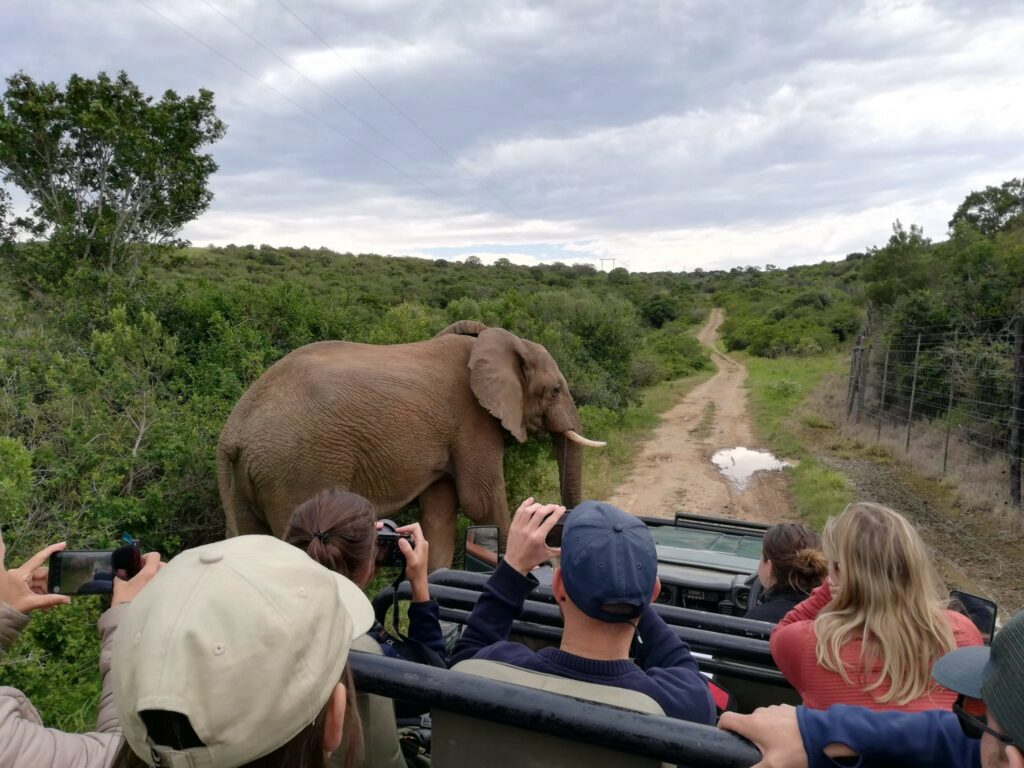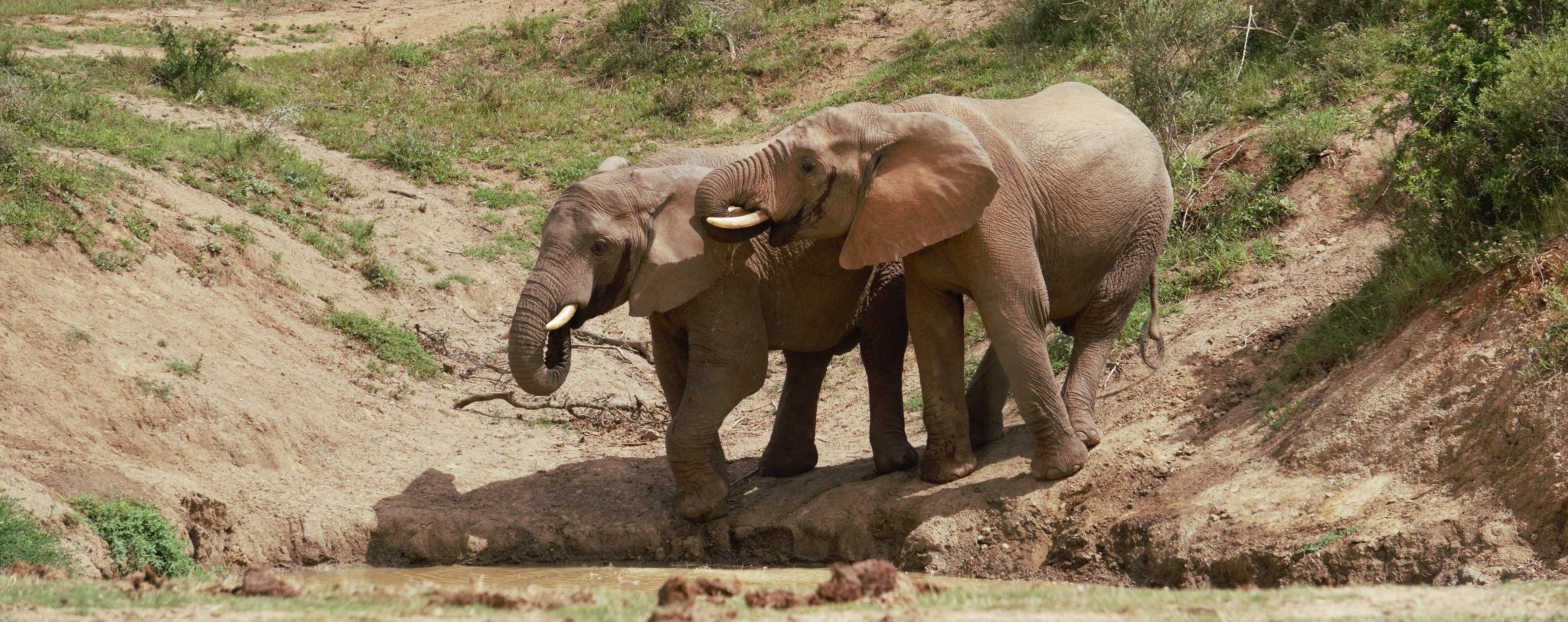And just like that… another week has flown by on the Kariega Game Reserve!
On Tuesday, we kicked off the educational program we had been preparing last week with the Matriarchs and community coaches and visited the first of three primary schools in the surrounding community. Excitement and nervous anticipation filled the classrooms as BTEH volunteers, coupled with a group of Kariega volunteers, the Matriarchs (the all female anti poaching unit), and a team of other community leaders rolled out a program rife with elephant facts and fun activities for the kids. The children got to learn the differences between Asian and African elephants, how elephants are crucial animals within their ecosystem as they aid in seed dispersal and maintain grasslands. But perhaps most importantly, the children were instilled with the message that elephants are very similar to humans, and that they too, have families and communities.
The Matriarchs opened the children’s eyes to the world of anti-poaching practices and reinforced the idea that hunting endangered animals is punishable by law. The program wrapped up with a fun art activity in which children got a chance to creatively reflect on their new knowledge by drawing or writing on a paper puzzle piece that would collectively form a mosaic elephant. The day concluded with a beautiful Xhosa song and dance, led by the community leaders. All volunteers went back to the reserve for some much needed rest and time to assess and reflect on the day.
As with most things in life, the first go-around always leaves room for improvement. That evening we sat down to improve the program. The aim of the program had been to allow community leaders to perform this activity on their own, and on the first day they gradually took ownership over the program. The second and third days were completely in the hands of the local community members, and the lectures were a mix of Xhosa and English to allow a deeper understanding of the message. The reasoning behind this was to try to ensure sustainability and continuity of the program in the hopes that other communities can adopt it and spread the important message of wildlife conservation. It was also decided to significantly reduce the number of volunteers present during the day to eliminate confusion and chaos for both volunteer and child alike.
The following community school days (on Thursday and Friday) went much smoother and left collectively a great feeling for all those involved. The BTEH pioneers are looking forward to analyzing the ‘post assessment’ evaluations of the children to gage how much was learned and retained.

On Wednesday we were very lucky that the head ecologist of Kariega, Chris, was willing to take us for trekking elephants on foot! This was very exciting, because we were in the same part of the reserve where the lions, buffalo’s and both rhino species live. Chris has years of experience in trekking animals on foot. We had to follow him in a straight line, had to be quiet and he would instruct us with signs (if we had to stop, knee or come back to him when he went ahead to scan the surroundings). We were able to get quite close to a lone bull elephant, who was very relaxed and was just browsing. When we headed on to a bigger herd, we crossed paths with a herd of buffalos – definitely our cue to retreat! When we were at a safe distance from the animals, Chris shared a lot of his extensive knowledge about the African bush: from identifying a pile of rhino poop to how elephants tend to migrate. A very interesting afternoon!
That night we had a braai with all the volunteers and the matriarchs and community coaches. Braai is a very South African tradition and means firing up a big barbeque. The evening was completed with some African music and dance.
On Thursday and Friday, while half of the group was at the school programs, the other half of the volunteers stayed at Kariega Conservation Center (KCC), and were busy with entering the data we had collected of the elephants in the field and the assessments of the first school group. They also worked on the elephant identification, sorting out the pictures and individual codes that were created of the elephants. At last, a brainstorm with the Kariega volunteers was held, to gather ideas to further improve the educational program in the future.
The weekend was again full with elephant research drives, of which we will never tire. We saw many elephants this weekend, and had some very good sightings again. We came across a group of sub-adult bulls who were play-sparring under the watchful eyes of two adult bulls, making sure that the younger ones would not get too rough. On Sunday we were following a small herd of five elephants to a waterhole. We were quietly observing them, when all of a sudden a big group of elephants came from behind us, running towards the waterhole. We ended up with close to 30 elephants together. Young calves were playing in the water and the adults were drinking and bathing. Absolutely beautiful to be able to watch this big gathering of elephants. How quickly they arrived, and how quickly they left. In a few minutes only an Egyptian goose was still present at the waterhole, like nothing happened.
Sunday afternoon our driver Thomas took us to the other side of the reserve where the hippos are living. He brought us to an observation platform with a beautiful sight on the river, where we got a glimpse of these funny animals. We even saw a monitor lizard swimming in between them. On our way towards the hippos, we shared the road with an Ostrich family, two adults with as many as 14 little chicks!
Next week will contain more research drives and we will head back to the community again for a community workshop. We will tell you all about this next week! And we’ll keep our fingers crossed with the new COVID variety and our trips back to our home countries.
Angelica Krouwer & Mara van Maarschalkerweerd
November, 2021
Kariega Game Reserve, Eastern Cape, South Africa
‹ Back to previous page